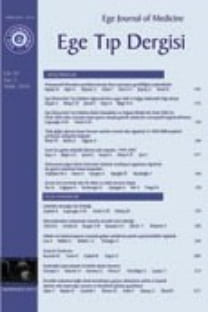Diffüz idiyopatik iskelet hiperostozlu bir hastada minör travma ile gelişen subakut torakal omurilik yaralanması
Subacute thoracic spinal cord injury caused by minor trauma in a patient with diffuse idiopathic skeletal hyperostosis
___
- 1. Kurtaran A, Özdemir S, Selçuk B, Yıldırım Ö, Değirmenci İ, Akyüz M. Servikal bölgedeki yaygın idiopatik iskelet hiperostozuna bağlı gelişen santral kord sendromu. Türkiye Fiziksel Tıp ve Rehabilitasyon Dergisi 2012;58(4):326-8.
- 2. Belanger TA, Rowe DE. Diffuse idiopathic skeletal hyperostosis: Musculoskeletal manifestations. J Am Acad Orthop Surg 2001;9(4):258-67.
- 3. Resnick D. Diffuse idiopathic skeletal hyperostosis. In: Resnick D (ed). Diagnosis of Bone and Joint Disorders. 4th ed., Philadelphia; Saunders; 2002;1476-1503.
- 4. Wang YF, Teng MM, Chang CY, Wu HT, Wang ST. Imaging manifestations of spinal fractures in ankylosing spondylitis. Am J Neuroradiol 2005;26(8):2067-76.
- 5. Graham B, Van Peteghem PK. Fractures of the spine in ankylosing spondylitis. Diagnosis, treatment, and complications. Spine 1989;14(8):803-7.
- 6. Secin FP, Poggi EJT, Luzuriaga F, Laffaye HA. Disabling injuries of the cervical spine in Argentine rugby over the last 20 years. Br J Sports Med 1999;33(1):33-6.
- 7. Hendrix RW, Melany M, Miller F, Rogers LF. Fracture of the spine in patients with ankylosis due to diffuse skeletal hyperostosis: Clinical and imaging findings. Am J Roentgenol 1994;162 (4):899-904.
- 8. Schroder J, Liljenqvist U, Greiner C, Wassmann H. Complications of halo treatment for cervical spine injuries in patients with ankylosing spondylitis--report of three cases. Arch Orthop Trauma Surg 2003;123(2-3):112-4.
- 9. Corke CF. Spinal fracture and paraplegia after minimal trauma in a patient with ankylosing vertebral hyperostosis. Br Med J 1981;282(6281):2035.
- ISSN: 1016-9113
- Yayın Aralığı: 4
- Başlangıç: 1962
- Yayıncı: Ersin HACIOĞLU
Kadınlarda sakral nöromodulasyonun etkinliği ve yaşam kalitesine etkisi
Şenol TONYALI, Hakan Bahadır HABERAL, Cenk Yücel BİLEN, Ali ERGEN
Hashimoto ensefalopatisi: İki olgu sunumu
Alper DÖVENTAŞ, Muazzez Gökçen KARAHAN, Zerrin YILDIRIM, Sevim BAYBAŞ, Yavuz ALTUNKAYNAK
Çölyak hastalığı'nda teşhis süresi
Kontakt lens kullanımının oküler yüzey ve Meibomian bezleri üzerine etkileri
Melis PALAMAR, Jale MENTEŞ, Ayşe YAĞCI, Özlem BARUT SELVER
Glukoz metabolizma bozukluklarında subklinik aterosklerozun değerlendirilmesi
Elçin AYDIN, Cihan ALTIN, Sinan EMRE, Muhteşem AĞILDERE, Mustafa Agah TEKİNDAL
Şükran GÜZEL, Ajda BAL, İbrahim GÜNDOĞDU, Deniz ERDOĞDU, Aytül ÇAKCI
Santral venöz portların çıkarılma nedenleri: Ardışık 154 hastadan edinilen deneyim
Fatih UZUNKAYA, Ayşegül İdil SOYLU, Ümit BELET, Özlem TERZİ, Hüseyin AKAN
Uzun süreli proton pompa inhibitörü kullanımına sekonder gastrik nöroendokrin hiperplazi
Fatma Özge KAYHAN KOÇAK, Zeliha Fulden SARAÇ, Sercan ŞAHUTOĞLU, Sevnaz ŞAHİN, Bahattin GÖKDEMİR, Selahattin Fehmi AKÇİÇEK
Moodle ile internet destekli biyoistatistik dersinin değerlendirilmesi
